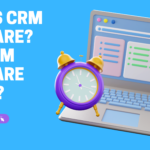In the fiercely competitive landscape of startups, customer relationship management (CRM) is no longer a luxury, it’s a necessity. But for young companies with limited budgets, expensive enterprise-grade CRM solutions might seem out of reach. Here’s the good news: a new wave of low-cost CRM software has emerged, offering powerful features and significant benefits at a fraction of the traditional cost. This comprehensive guide explores the world of low-cost CRM, outlining its importance for startups, key features, implementation strategies, and future trends.
1. Understanding CRM and Its Importance for Startups
1.1 The Basics of CRM
CRM stands for Customer Relationship Management. It’s a technology that helps businesses track and manage interactions with their customers and potential customers (leads). Early CRMs were simple contact management tools, but modern CRMs are sophisticated platforms that offer a wide range of features, including:
- Contact management
- Sales pipeline management
- Marketing automation
- Reporting and analytics
- Integration with other business applications
1.2 Why Startups Need CRM
Startups face unique challenges when it comes to managing customer relationships. Here’s how a low-cost CRM can be a game-changer:
- Tracking customer interactions: Consolidate all customer data (emails, calls, meetings, notes) in one central location for a complete customer view.
- Managing leads and sales pipelines: Effectively track leads through the sales funnel, nurturing them into paying customers.
- Enhanced customer relationships: Personalize communication, improve responsiveness, and build stronger customer loyalty.
- Improved sales management: Automate tasks, improve forecasting, and close more deals.
1.3 Challenges Faced by Startups Without CRM
The absence of a CRM can lead to:
- Disorganized customer information: Scattered data across spreadsheets and emails makes it difficult to get a holistic view of customers.
- Inefficient sales processes: Manual processes slow down the sales cycle and lead to missed opportunities.
2. The Economic Impact of Low-Cost CRM on Startups
2.1 Cost Savings
Low-cost CRM software offers significant cost savings compared to traditional enterprise CRM solutions. Here’s how:
- Reduction in operational costs: Automate tasks, eliminate data silos, and streamline workflows for increased efficiency.
- Comparing costs of different CRM solutions: Research and compare pricing plans from various vendors to find the best fit for your budget.
2.2 ROI of Investing in a CRM
Investing in low-cost CRM delivers both short-term and long-term benefits:
- Short-term benefits: Increased sales pipeline visibility, improved lead conversion rates, and streamlined sales processes.
- Long-term benefits: Enhanced customer retention, improved customer lifetime value (CLTV), and increased brand loyalty.
Case studies: Showcase real-world examples of startups that achieved significant ROI through low-cost CRM implementation.
2.3 Budgeting for CRM
- How to allocate funds for CRM: Allocate a specific portion of your marketing or sales budget for CRM software.
- Hidden costs to be aware of: Consider any additional costs like data migration or custom integrations.
2.4 Funding and Financial Support
- Grants and support for digital tools: Research government grants or incubator programs that offer financial support for digital tools like CRM.
- Tips for securing funding: Highlight the potential ROI of low-cost CRM software when seeking funding from investors.
3. Key Features of Low-Cost CRM Software
3.1 Core Functions
- Contact management: Store and manage all customer data in a centralized location.
- Sales pipeline management: Track leads through different stages of the sales funnel.
3.2 Must-Have Features for Startups
- Automation tools: Automate repetitive tasks like email follow-ups or data entry.
- Integration capabilities: Integrate with existing tools like email marketing platforms or accounting software.
3.3 Comparing Features Across Different Platforms
- What to look for in a CRM: Consider features like ease of use, scalability, and mobile access when comparing different CRM solutions.
- Top low-cost CRM software comparison: Create a table comparing popular low-cost CRM options based on features, pricing, and target user base.
3.4 Customization and Scalability
- Customizing for your startup’s needs: Choose a CRM that allows you to customize fields, workflows, and dashboards to fit your specific business needs.
- Planning for growth: Ensure the CRM you choose can scale with your startup as it grows.
4. Implementing Low-Cost CRM in Your Startup
4.1 The Implementation Process
Implementing a new CRM system can seem daunting, but following a step-by-step approach ensures a smooth transition:
- Define your CRM goals: Clearly define what you want to achieve with the CRM, such as improving lead conversion rates or streamlining the sales cycle.
- Choose the right CRM software: Research and compare different options based on your needs, budget, and team size.
- Data migration (optional): If you’re transitioning from another system, ensure a smooth data migration process to avoid data loss.
- System configuration: Customize the CRM to fit your business processes and workflows.
- Team training: Provide comprehensive training to your team on using the CRM effectively.
Common pitfalls to avoid:
- Rushing the implementation process: Take your time to configure the system correctly and train your team.
- Poor data hygiene: Ensure accurate and consistent data entry to avoid data quality issues.
- Lack of user adoption: Promote CRM usage within your team and address any concerns or challenges.
4.2 Training Your Team
- Best practices for CRM training: Provide a combination of online resources, video tutorials, and hands-on training sessions.
- Creating a culture of CRM use: Encourage team members to actively use the CRM and share best practices.
4.3 Measuring Success
- Key performance indicators (KPIs): Identify key metrics to track progress towards your CRM goals, such as lead conversion rates, sales cycle length, and customer satisfaction scores.
- Adjusting strategies based on data: Regularly analyze CRM data and use insights to adjust your sales and marketing strategies.
4.4 Ongoing Management and Support
- Maintenance tips: Schedule regular system updates and backups to ensure optimal performance.
- Leveraging customer support: Utilize the support resources provided by your CRM vendor to address any issues.
5. Case Studies: Startups That Thrived with Low-Cost CRM
5.1 Overview of Selected Startups
Showcase 2-3 real-life examples of startups from different industries that successfully implemented low-cost CRM solutions. Briefly describe their business background and the challenges they faced before implementing CRM.
5.2 Implementation Strategies
- How they chose their CRM: Explain the factors considered by each startup when choosing their specific low-cost CRM software.
- Integration into existing workflows: Describe how the CRM was integrated with their existing business tools and processes.
5.3 Outcomes and Benefits
- Quantifiable improvements: Highlight measurable results achieved by each startup after implementing the CRM, such as increased sales figures or improved customer satisfaction scores.
- Qualitative feedback from teams and customers: Include quotes or testimonials from team members and customers showcasing the positive impact of the CRM.
5.4 Lessons Learned
- Insights and advice for other startups: Summarize key takeaways from each case study that other startups can learn from when implementing their own low-cost CRM.
6. Future Trends in CRM for Startups
6.1 AI and Machine Learning in CRM
- Predictive analytics: Leverage AI to predict customer behavior and automate personalized interactions.
- Personalized customer experiences: Use machine learning to tailor marketing campaigns and customer support based on individual customer preferences.
6.2 The Role of Big Data
- Data-driven decision making: Utilize CRM data to gain valuable insights into customer behavior and market trends.
- Enhancing customer understanding: Gain a deeper understanding of your customers and their needs.
6.3 Mobile CRM
- The importance of mobile access: Enable your team to access and manage customer data on the go.
- Features and benefits: Highlight the benefits of mobile CRM features like real-time data access, task management, and mobile reporting.
6.4 Integrations and Ecosystems
- The growing need for interconnected tools: Modern CRMs integrate seamlessly with a wide range of business applications.
- Examples of powerful integrations: Showcase examples of how CRM integrations can streamline workflows and enhance functionality (e.g., integrating CRM with accounting software for automatic invoicing).
7. Choosing the Right Low-Cost CRM for Your Startup
7.1 Identifying Your Needs
- Assessing your startup’s specific requirements: Identify your specific needs and functionalities required in a CRM solution before selecting one.
- The importance of scalability: Choose a CRM that can scale with your startup’s growth.7.2 Research and Reviews
7.2 Research and Reviews
- Utilizing online resources: Leverage online resources like software review websites, industry blogs, and user forums to gather insights and recommendations for low-cost CRM solutions.
- What to look for in user reviews: Pay attention to user reviews that highlight the strengths and weaknesses of different CRM platforms, focusing on aspects relevant to startups.
7.3 Trial Periods and Demos
- Making the most of free trials: Take advantage of free trial periods offered by many low-cost CRM vendors to test-drive the software and experience its functionalities firsthand.
- Questions to ask during demos: Prepare a list of questions to ask during CRM vendor demos, focusing on features, pricing plans, and customer support options.
7.4 Making the Final Decision
- Checklist for final evaluation: Create a checklist outlining key criteria for evaluating different CRM options (e.g., features, ease of use, scalability, integrations, pricing).
- Avoiding common selection mistakes: Don’t be swayed solely by price. Consider factors like long-term scalability, user experience, and customer support quality.
Final thoughts on the impact of low-cost CRM:
- Conclude by reiterating the game-changing impact that low-cost CRM software can have on a startup’s growth and success.
- Emphasize the improved customer relationships, streamlined workflows, and data-driven decision making facilitated by CRM.
9. FAQs
5 Frequently Asked Questions about Low-Cost CRM for Startups
- What are the biggest challenges startups face when managing customer relationships?
Startups often struggle with scattered customer data, inefficient sales processes, and a lack of visibility into customer interactions.
- How can low-cost CRM help startups overcome these challenges?
Low-cost CRM provides a central platform for storing and managing customer data, automates tasks, and offers valuable insights into customer behavior.
- What are some key features to look for in a low-cost CRM for startups?
Look for features like contact management, sales pipeline management, automation tools, and integrations with existing business tools.
- How much does low-cost CRM software typically cost?
Pricing varies depending on the vendor and features offered, but low-cost CRM solutions are generally much more affordable than traditional enterprise CRM systems.
- What are some tips for successfully implementing a low-cost CRM in a startup?
Clearly define your goals, choose the right software, train your team, and regularly monitor key performance indicators (KPIs).












